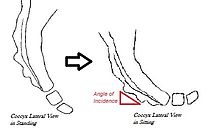Coccygodynia
| Classification according to ICD-10 | |
|---|---|
| M53.3 | Diseases of the sacrococcygeal region, not elsewhere classified - coccygodynia |
| ICD-10 online (WHO version 2019) | |
Coccydynia (lat. Notation Coccygodynia ) is the technical term for chronic pain in the area of the tailbone ( coccyx ). The disease often has no demonstrable cause and is then referred to as idiopathic .
Possible causes are poorly healed injuries or fractures or congenital malformations of the coccyx, deep herniated discs , tumors , mechanical overload after childbirth and accidents, chronic constipation , diseases of the attachment tendons of the muscles of the pelvic floor or the pelvic organs. Obesity is a risk factor.
A tailbone target image can be made to confirm the diagnosis. Their informative value is limited, however, because the angle at which the tailbone stands to the sacrum is very variable (norm 10–30 °). An MRI scan is more sensitive, as it can be used to better assess the bony injuries and the damage to the soft tissue. The gold standard of diagnostics is still the clinical examination. The examiner inserts the index finger rectally and moves the tailbone between the thumb and index finger. Painful mobility (possibly with palpable bone rubbing "crepitation") is a diagnostic confirmation ("pathognomonic").
80% of those affected are female. They complain of pain when sitting, defecating, or having sexual intercourse. In addition to the orthopedic examination, including palpation from the rectum (for mobility and tenderness of the bone), a gynecological examination is useful. The imaging procedures ( x-rays of the coccyx, computed tomography , magnetic resonance tomography ) usually do not reveal any visible changes, but should still be carried out to rule out local inflammation or a tumor.
treatment
The disease is feared because of its length. If the cause cannot be found, local infiltration with corticosteroids or local anesthetics at the junction between the sacrum and tailbone can be attempted. Ineffectiveness should only be determined after three months. Pain relievers in tablet form can be used to assist. Furthermore, the provision of a seat ring, physiotherapy and possibly psychotherapy is appropriate. As with all long-term complaints for which there is no prospect of rapid improvement, complementary medical procedures are often used . It is important for the patient to point out that the disease is not threatening or even life-threatening. As a last resort , surgical removal of the coccyx applies. In smaller, retrospectively compiled case series, success rates of more than 80% have been reported for this operation.
literature
- Hans Peter Bischoff, Jürgen Heisel, Hermann Locher: Practice of conservative orthopedics . Georg Thieme Verlag, 2007, ISBN 978-3-13-142461-7 , pp. 459-60.
- Jan Van Zundert: Evidence-based Interventional Pain Practice: According to Clinical Diagnoses . John Wiley & Sons, October 19, 2011, ISBN 978-1-119-96835-1 , pp. 103-7.
Individual evidence
- ↑ MRI images of the coccyx
- ↑ Tailbone pain (coccygodynia) - causes, symptoms, therapy, Onmeda.de
- ↑ Coccyx Pain Essentials : Patrick M Foye, Coccyx Pain - Practice Essentials, Medscapes Feb 03, 2017
- ↑ Pennekamp, PH, Kraft CN, et al .: The tailbone resection in the treatment of coccygodynia. Z Orthop your Grenzgeb 2003; 141 (5): 578-582 doi : 10.1055 / s-2003-42842 PMID 14551847 .
- ↑ EE Kerr, D. Benson, RJ Schrot: Coccygectomy for chronic refractory coccygodynia: clinical case series and literature review. In: Journal of Neurosurgery: Spine . Volume 14, Number 5, May 2011, pp. 654-663. doi : 10.3171 / 2010.12.SPINE10262 . PMID 21332277 . (Review).
- ↑ SW Cheng, QY Chen, ZQ Lin, W. Wang, W. Zhang, DQ Kou, Y. Shen, XZ Ying, XJ Cheng, CZ Lü, L. Peng: Coccygectomy for stubborn coccydynia. In: Chinese journal of traumatology = Zhonghua chuang shang za zhi / Chinese Medical Association. Volume 14, Number 1, February 2011, pp. 25-28. PMID 21276364 .

